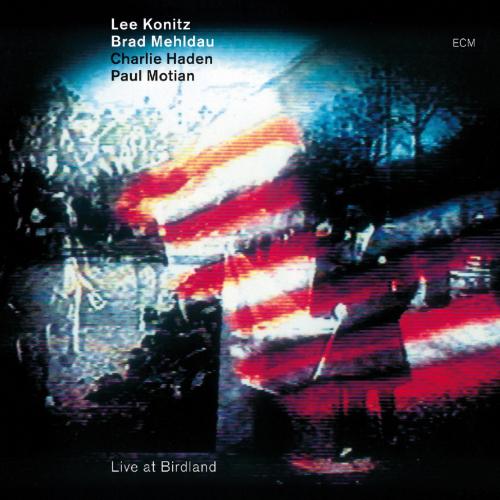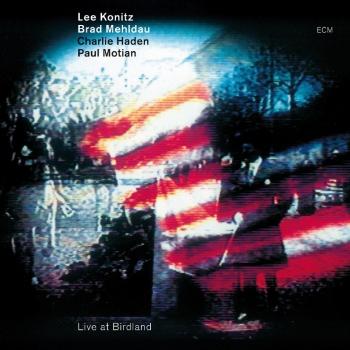
Live At Birdland Lee Konitz, Brad Mehldau, Charlie Haden, Paul Motian
Album Info
Album Veröffentlichung:
2011
HRA-Veröffentlichung:
11.07.2017
Label: ECM
Genre: Jazz
Subgenre: Contemporary Jazz
Interpret: Lee Konitz, Brad Mehldau, Charlie Haden, Paul Motian
Das Album enthält Albumcover Booklet (PDF)
Entschuldigen Sie bitte!
Sehr geehrter HIGHRESAUDIO Besucher,
leider kann das Album zurzeit aufgrund von Länder- und Lizenzbeschränkungen nicht gekauft werden oder uns liegt der offizielle Veröffentlichungstermin für Ihr Land noch nicht vor. Wir aktualisieren unsere Veröffentlichungstermine ein- bis zweimal die Woche. Bitte schauen Sie ab und zu mal wieder rein.
Wir empfehlen Ihnen das Album auf Ihre Merkliste zu setzen.
Wir bedanken uns für Ihr Verständnis und Ihre Geduld.
Ihr, HIGHRESAUDIO
- 1 Lover Man (Live) 11:59
- 2 Lullaby Of Birdland (Live) 10:17
- 3 Solar (Live) 11:39
- 4 I Fall In Love Too Easily (Live) 10:17
- 5 You Stepped Out Of A Dream (Live) 11:49
- 6 Oleo (Live) 15:19
Info zu Live At Birdland
Ein Gipfeltreffen zwischen drei alten und einem jüngeren Meister in einem der legendärsten Jazzclubs der Welt: Auf “Live At Birdland” interpretieren sie ein halbes Dutzend Jazzklassiker.
Manche Alben sprechen schon für sich selbst bevor man sie überhaupt gehört hat. Im Fall von "Live at Birdland" passiert dies derartig eloquent, dass auch der härteste Jazzfan keinen Grund mehr findet die chronisch nervösen Augenbrauen zu runzeln. Im Gegenteil, denn die hier dargebotenen Klassiker vom Schlage "Lover Man" und "Lullaby of Birdland" hatten in ihrem Schmiss schon immer die Fähigkeit auch erklärte Nicht-Jazz-Hörer auf ihre Seite zu ziehen. Lee Konitz, Brad Mehldau, Charlie Haden und Paul Motian mit dem perfekten Standards-Set live auf der Bühne des legendären New Yorker Birdlands - da ist der (Core) Jazz-Bestseller der Saison abzusehen!
Während die meisten Musiker ab einem gewissen Alter konservativer werden und auf Nummer sicher gehen, verlief die Entwicklung bei Lee Konitz erstaunlicherweise in die entgegengesetzte Richtung. Er begann als Swingmusiker, etablierte sich dann mit Bebop und Cool-Jazz, bevor er die Jazzwelt dadurch überraschte, dass er mit zunehmendem Alter immer experimentierfreudiger wurde. In Paul Motian, Charlie Haden und Brad Mehldau fand er nun kongeniale Partner. Motian und Haden, mittlerweile 79 respektive 73 Jahre alt, waren Pioniere des freien, improvisierten Spiels und zählen immer noch zur innovativen Speerspitze des Jazz. Der erst 40-jährigen Brad Mehldau wiederum gilt als einer der aufregendsten und vielseitigsten Pianisten der jüngeren Generation. Gemeinsam hauchen sie hier den Klassikern “Lover Man”, “Lullaby Of Birdland”, “Solar”, “I Fall In Love Too Easily”, “You Stepped Out Of A Dream” und “Oleo” frisches Leben ein und lassen sie klingen, als wären sie gerade erst von ihnen selbst kreiert worden.
„Sechs Titel aus der Session zeigen, wie aufmerksam sich Konitz, Brad Mehldau (p), Charlie Haden (b) und Paul Motian (dr) zuhörten, Wagnisse eingingen, reagierten und feinfühlig musizierten." (Audio)
„Alt-Männer-Jazz: sperrig und sensibel." (Stereoplay)
„Delikat." (Stereo)
Lee Konitz, Altsaxophon
Brad Mehldau, Klavier
Charlie Haden, Kontrabass
Paul Motian, Schlagzeug
Lee Konitz
was born October 13, 1927 in Chicago Illinois. Spanning the bebop to avant garde genres, altoist Konitz is best known as one of the pioneers of the “Cool Jazz” sound and for his role in the legendary “Birth of the Cool” album with Miles Davis. Konitz himself credited an early mentor, pianist Lennie Tristano with the seeds of that movement. Growing up listening to big bands, Konitz retained a distinctive sound apart from his good friend Charlie Parker and influenced Paul Desmond and Art Pepper. Konitz released his first album among many as leader in 1949, and performed with such artists as Stan Kenton in the 60s, Elvin Jones, Dave Brubeck, Gerry Mulligan, Ornette Coleman and others, becoming more experimental in his later career.
Brad Mehldau
Jazz pianist Brad Mehldau has recorded and performed extensively since the early 1990s. Mehldau’s most consistent output over the years has taken place in the trio format. Starting in 1996, his group released a series of five records on Warner Bros. entitled The Art of the Trio (recently re-packaged and re-released as a 5-Disc box set by Nonesuch in late 2011). During that same period, Mehldau also released a solo piano recording entitled Elegiac Cycle, and a record called Places that included both solo piano and trio songs. Elegiac Cycle and Places might be called “concept” albums made up exclusively of original material with central themes that hover over the compositions. Other Mehldau recordings include Largo, a collaborative effort with the innovative musician and producer Jon Brion, and Anything Goes—a trio outing with bassist Larry Grenadier and drummer Jorge Rossy.
His first record for Nonesuch, Brad Mehldau Live in Tokyo, was released in September 2004. After ten rewarding years with Rossy playing in Mehldau’s regular trio, drummer Jeff Ballard joined the band in 2005. The label released its first album from the Brad Mehldau Trio—Day is Done—on September 27, 2005. An exciting double live trio recording entitled Brad Mehldau Trio Live wasreleased on March 25th, 2008 (Nonesuch) to critical acclaim. On March 16, 2010 Nonesuch released a double-disc of original work entitled Highway Rider, the highly anticipated follow up to Largo. The album was Mehldau’s second collaboration with renowned producer Jon Brion and featured performances by Mehldau’s trio—drummer Jeff Ballard and bassist Larry Grenadier—as well as percussionist Matt Chamberlain, saxophonist Joshua Redman, and a chamber orchestra led by Dan Coleman. In 2011 Nonesuch released Live in Marciac—a two CD release with a companion DVD of the 2006 performance, and Modern Music, a collaboration between pianists Brad Mehldau and Kevin Hays and composer/arranger Patrick Zimmerli. In 2012 Nonesuch released an album of original songs from the Brad Mehldau Trio—Ode—the first from the trio since 2008’s live Village Vanguard disc and the first studio trio recording since 2005’s Day is Done. Ode went on to garner a Grammy-Nomination. Nonesuch released the Brad Mehldau Trio’s Where Do You Start, a companion disc to the critically acclaimed Ode, in the fall of 2012. Whereas Ode featured 11 songs composed by Mehldau, Where Do You Start comprises the Trio’s interpretations of 10 tunes by other composers, along with one Mehldau original. In 2013 Mehldau produced and performed on Walking Shadows, the acclaimed Nonesuch release from Joshua Redman. 2013 also saw a number of collaborative tours including a duo tour with mandolin virtuoso Chris Thile, piano duets with Kevin Hays and a new electric project with prodigious drummer Mark Guiliana entitled “Mehliana.” Mehliana: Taming the Dragon, the debut release by Mehliana, was released in early 2014. Mehldau’s monumental and ambitious 10 Years Solo Live eight-LP vinyl box set was released to unanimous critical acclaim on October 16th, 2015 (with CD and digital versions released in November). The set was culled from 19 live recordings made over a decade of the pianist’s European solo concerts and was divided into four thematic subsets of four sides each: Dark/Light, The Concert, Intermezzo/Rückblick, and E Minor/E Major. In 2016, Nonesuch Records released the Brad Mehldau Trio’s highly-anticipated Blues and Ballads—the ensemble’s first new release since 2012’s Where Do You Start—and the celebrated debut album of the Joshua Redman/Brad Mehldau Duo, Nearness, featuring recordings from their 2011 European tour. Both albums have received universal from critics and audiences alike, and both have earned a Grammy nomination for Mehldau. Mandolinist/singer Chris Thile joins Mehldau for their debut release in 2017: Chris Thile & Brad Mehldau.
Charles Edward "Charlie" Haden
(August 6, 1937 – July 11, 2014) was an American jazz double bass player, bandleader, composer and educator known for his deep, warm sound, and whose career spanned more than fifty years. In the late 1950s, Haden was an original member of the ground-breaking Ornette Coleman Quartet.
Haden revolutionized the harmonic concept of bass playing in jazz. About him, German musicologist Joachim-Ernst Berendt commented, "His ability to create serendipitous harmonies by improvising melodic responses to Coleman's free-form solos (rather than sticking to predetermined harmonies) was both radical and mesmerizing. His virtuosity lies…in an incredible ability to make the double bass 'sound out'. Haden cultivated the instrument's gravity as no one else in jazz. He is a master of simplicity which is one of the most difficult things to achieve." [1]) Haden played a vital role in this revolutionary new approach, evolving a way of playing that sometimes complemented the soloist and sometimes moved independently. In this respect, as did his predecessor bassists Jimmy Blanton and Charles Mingus, Haden helped liberate the bassist from a strictly accompanying role to becoming a more direct participant in group improvisation. In 1969, he formed his first band, the Liberation Music Orchestra, featuring arrangements by pianist Carla Bley. In the late 1960s, he became a member of pianist Keith Jarrett's trio, quartet and quintet. In the 1980s, he formed his band, Quartet West. Haden also often recorded and performed in a duo setting, with musicians including guitarist Pat Metheny and pianist Hank Jones. …
Paul Motian
was born in Philadelphia in 1931 and from the age of two, he grew up in Providence, Rhode Island. His first musical attraction was the guitar. As he explains to Downbeat "because I liked cowboy movies - the guy puts his guitar around his neck, strums, sings - that looks like fun, I thought, 'I want to do that'". But his musical interests switched to the drums: he soon graviated to a neighbourhood drummer by the age of 12 he was taking his first lessons.
Paul played in school bands until his high school graduation in 1949. He played local gigs around Providence before catching on with a band that toured New England playing stock big band arrangements. But he was as well listening to bebop innovators like Charlie Parker, Max Roach, Bud Powell and Dizzy Gillespie.
Soon the Korean War forced him to join the Navy which he left at the age of 24. He moved to New York the same year and began playing professionally. "There used to be a lot of sessions in New York", Paul told Downbeat "there were chances to play. At the 'Open Door' near where NYU is now, they had sessions during the week and on weekends Monk or Bird. One night Arthur Taylor didn't show up, and Bob Reisner, who was running the sessions said, 'Go, get your drums, you can play with Thelonious'. I ran home, got the drums, ran back, played with Thelonious and at the end of the night he gave me $10. I was the happiest guy in the world".
Around this time Motian met Bill Evans. They played together in Tony Scott's group. Soon Paul had extended work with Lennie Tristano. He also recorded with George Russell and had opportunities to play with masters as Sonny Rollins and John Coltrane. The now legendary Bill Evans trio with Scott LaFaro (1959/64) broke new ground in terms of how the group members shared musical functions - blurring the distinctions between soloist and accompainists; heightening the standards for group interplay in the process. It has proven to be one of the most pervasively influential groups in Modern Jazz history. Throughout the 50's and 60's, Paul frequently worked with group leaders like Coleman Hawkins, Oscar Pettiford, Charles Lloyd, Pharoah Sanders, Mose Allison and folk-singer Arlo Guthrie (at Woodstock). In fact Paul sometimes regrets today that he turned down the opportunity to become the second drummer in Coltrane's group - the seat that was eventually taken by Rashied Ali.
The 60's found Motian along with other drum innovators like Elvin Jones, Tony Williams, Blackwell, Billy Higgins and Roy Haynes developing an approach to jazz drumming that captured the pulse of the music - providing meter without the explicit repetition of earlier styles. Motian mastered the nuances of color, texture and melody that take the function of the drums well beyond that of time and propulsion of the group into the more challenging realms of composition and utilizing space. …
Booklet für Live At Birdland







